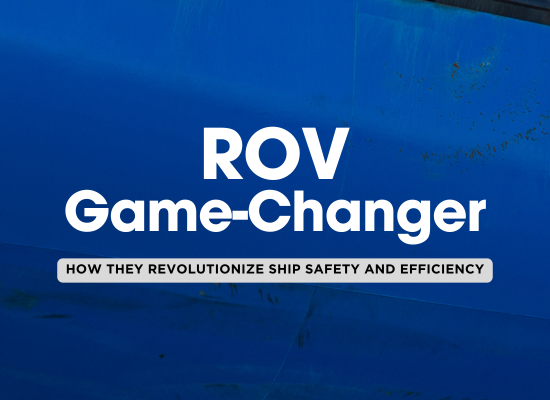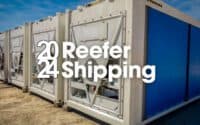Essential or Optional? The Case for an Underwater ROV on every Ship

Underwater ROVs have emerged as a revolutionary tool, providing ship owners with unparalleled capabilities to inspect and maintain their ships with precision and ease. From post-storm inspections and corrosion assessments to ballast tank evaluations and pollution checks, these versatile ROVs offer a comprehensive solution for a multitude of maritime challenges. But are they Essential or Optional? Let's find out!
* Please send feedback/suggestions to editor @ shipuniverse.com
Why an Underwater ROV May Be Essential
Underwater ROVs provide ship operators with a real-time view of their vessel's submerged components, allowing for early detection of issues that could lead to costly repairs or downtime. In a competitive industry where every minute counts, the ability to perform quick inspections, monitor maintenance needs, and even assist in emergency scenarios can make an ROV indispensable. For ships operating in environments where professional divers are hard to access, or during situations that require immediate underwater intervention, ROVs offer a safe and cost-effective alternative.
| ShipUniverse: Why an Underwater ROV Might Be Essential | |||
| Task | Details | Benefits | Considerations |
| Hull Inspections | ROVs can inspect for cracks, biofouling, or damage to the hull. | Early detection of issues prevents costly repairs. | Initial investment in ROV equipment. |
| Propeller Maintenance | Check for damage or entanglements without needing divers. | Reduces downtime and ensures optimal propulsion. | May require training for crew to operate ROV effectively. |
| Emergency Repairs | ROVs can assist in identifying underwater issues quickly. | Minimizes risks to human divers in emergencies. | May not replace divers for complex repairs. |
| Ballast Tank Inspections | Inspect for structural integrity and corrosion in tanks. | Improves compliance with environmental regulations. | Limited by ROV size in tight spaces. |
| Environmental Monitoring | ROVs can monitor marine ecosystems around the vessel. | Ensures compliance with environmental standards. | Requires advanced sensors for specialized tasks. |
| Port Security | ROVs can be used to inspect for suspicious activity under the vessel. | Enhances security for high-risk cargo or vessels. | Additional training needed for security-focused use. |
| Salvage Operations | Assist in recovering lost cargo or equipment. | Faster and safer than deploying divers alone. | May require more advanced ROV models. |
| Surveying Seabeds | ROVs can map seabeds and identify underwater hazards. | Useful for route planning and anchoring. | Specialized equipment may increase costs. |
| Cost Savings | Eliminates the need for frequent diver deployments. | Reduces operational costs over time. | High upfront purchase cost for the ROV. |
| Improved Safety | ROVs keep humans out of potentially hazardous underwater environments. | Minimizes risk of accidents and injuries. | Dependence on ROV technology may require robust backup systems. |
💡 Find the right ROV for your needs—request quotes now!
Below, we break down over 20 example scenarios that highlight the compelling reasons for having an underwater ROV on board every ship.
🌪️ Post-Storm Inspection
After navigating through a severe storm, you suspect that floating debris may have caused damage to the hull. Deploying the ROV, you guide it along the ship’s sides and bottom, examining for any signs of impact or scraping. The ROV’s footage shows several areas with superficial scratches but no significant structural damage. This quick inspection allows you to confirm the hull’s integrity and continue your voyage without unnecessary delays.
🌀 Vibrations
Your vessel has been experiencing slight vibrations during operation, and you suspect the propeller might be fouled or damaged. Using the ROV, you inspect the propeller blades and find a tangled fishing net wrapped around one of them. The ROV’s live feed helps you direct the crew on how to safely remove the obstruction. This prompt action resolves the issue and restores the ship’s smooth operation without requiring divers.
⚙️ Concerned about Corrosion
During a routine maintenance check, you decide to inspect the hull for signs of corrosion. By maneuvering the ROV along the hull, you can closely examine welded joints, seams, and other potential weak points. The high-definition video footage can be recorded and reviewed later, or shared with experts for further analysis. This proactive approach helps in planning maintenance work and preventing severe damage.
🚢 A Minor Collision Entering Port
Your vessel experiences a minor collision with another ship in a busy port. Immediately after the incident, you deploy the ROV to inspect the hull for any damage. The ROV’s agile movement allows it to navigate around the hull and capture detailed images and videos of the impacted areas. You identify several areas of small damage but nothing major that will impact the vessel's performance. This quick assessment enables you to report accurate information to port authorities and decide on necessary repairs without delays.
🔧 Emergency Valve Operation
During a routine voyage, your cargo ship encounters an unexpected issue with one of its underwater intake valves. The valve is crucial for the ship's ballast system, but it has become stuck in the closed position, preventing proper ballast operations. This issue poses a significant risk to the ship's stability and balance, especially during rough seas. You deploy the ROV equipped with its advanced manipulator arm. The ROV is lowered into the water and guided to the location of the malfunctioning valve. Utilizing the manipulator arm's gripping and turning capabilities, the ROV carefully grasps the valve handle. With precise control, the ROV operator aboard the ship remotely turns the valve, successfully opening it and restoring proper function to the ballast system.
🏝️ Grounding on an Uncharted Sand Bank
While navigating through a channel post-hurricane, your ship runs aground on a new and uncharted sandbank. Concerned about potential damage to the hull, you deploy the ROV. The ROV quickly reaches the hull’s bottom, where you observe several areas with scrapes and some minor dents. The ROV's footage helps you assess the extent of the damage and decide whether the ship can safely continue its journey to the nearest port for repairs. This immediate assessment avoids the need for diver inspections, which could be dangerous in such conditions.
🎨 Recent Anti-Fouling Paint Suspicions
Your vessel was recently repainted with anti-fouling paint designed to prevent biofouling. After several months in service, you notice a slight decrease in performance and want to check the condition of this specialized coating. Deploying the ROV, you maneuver it along the hull to inspect the paint’s integrity. The ROV’s high-resolution camera reveals areas where the paint has worn off, allowing you to schedule touch-up work before biofouling becomes a problem. This preventive measure ensures the ship maintains optimal performance.
🔍 Suspicious Object
While anchored near a port, the crew spots a suspicious object floating toward the stern of the ship. The ROV is quickly deployed to investigate. The ROV’s camera reveals the object to be a large abandoned fishing net, which is promptly removed by the crew. This rapid response ensures the safety and security of the vessel without putting crew members at risk.
💡 Find the right ROV for your needs—request quotes now!
⚓ Mooring Line
While docked at a port, you receive a report that one of the mooring lines is showing signs of wear. The ROV is deployed to inspect the underwater sections of the mooring lines. The ROV’s camera reveals significant fraying on one line, prompting an immediate replacement to prevent the risk of the ship breaking free during rough weather.
🌊 Pollution Check
As part of your environmental compliance program, you periodically monitor the water quality around your ship. Using the ROV equipped with sensors, you measure parameters like turbidity and dissolved oxygen levels. The ROV’s data helps you ensure that your operations are not negatively impacting the marine environment, and the information is used for regulatory reporting.
📦 Cargo Retrieval
During a storm, some cargo containers were lost overboard. The ROV is deployed to locate and assess the condition of the lost containers. The ROV’s cameras locate the containers on the seabed, providing precise coordinates and visual confirmation. This information aids the salvage team in planning an efficient recovery operation.
🐚 Biofouling Check
Your ship has been at sea for several months, and you suspect that biofouling might be affecting the vessel's performance. Using an underwater ROV, you can deploy it from the deck to inspect the entire underwater portion of the hull. The ROV’s camera provides real-time video feed, allowing you to identify areas with significant biofouling. This information helps you decide if a cleaning operation is necessary, optimizing fuel efficiency and speed without the need for dry docking.
🏗️ Harbor Inspection
A recent and severe storm blew through an unfamiliar port. You use the ROV to inspect the underwater condition of the docking area. The ROV identifies submerged debris that could pose a hazard to the ship’s hull. This information allows the port authorities to clear the area, ensuring a safe docking procedure and preventing potential damage.
🛥️ Pre-Purchase Inspection
You are considering purchasing a second-hand vessel and want to ensure the hull is in good condition before finalizing the deal. Deploying the ROV, you conduct a thorough inspection of the hull, checking for any signs of previous damage, corrosion, or poor repairs. The ROV’s detailed footage provides you with critical information to make an informed decision about the purchase, potentially saving you from costly future repairs.
🔗 Pipeline Inspection
Your vessel operates near underwater pipelines, and you need to ensure these structures are not damaged or leaking. Using the ROV, you inspect the pipelines for any signs of wear, corrosion, or damage. The ROV’s camera captures detailed images, allowing you to report any issues to the relevant authorities for maintenance, thereby preventing environmental hazards and ensuring operational safety.
🛡️ Hull Integrity Check in High-Risk Areas
Your vessel operates in areas with a high risk of piracy. To ensure there are no sabotage attempts, you deploy the ROV to inspect the hull and underwater sections of the ship for any suspicious devices or tampering. The ROV’s thorough inspection provides peace of mind and enhances the security protocols of your vessel.
⚓ Anchor Retrieval
While anchored at a busy port, your ship's anchor gets entangled with an underwater obstruction. Using the ROV, you inspect the entanglement to understand the situation better. The ROV's footage helps the crew devise a strategy to free the anchor without causing damage to the ship or the underwater infrastructure.
🛢️ Oil Spill Detection
Your cargo ship carries hazardous materials, including oil. In case of a suspected leak, the ROV is deployed to monitor the water around the ship for any signs of oil spills. The ROV's sensors and camera provide real-time data, helping you quickly identify the source and extent of the spill, allowing for immediate containment measures.

Do you have a Maritime Product or Service that may be of interest to Shipowners? Tell us about it here!
Do you have feedback or insights? Please reach out to editor @ shipuniverse.com



